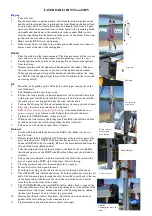
SSCC APPLICATIONS & PROGRAMMING GUIDELINES
_________________________________________________________________________________________________________
4-22
SIG-00-22-02 JUNE 2022 (Revised September 2022)
Version: B.1
4.9
Measuring Crossing Lamp Voltage using a Conventional Multimeter
WARNING
TO PREVENT AN OVERVOLTAGE CONDITION AT THE LAMPS, USE
A VOLTMETER WITH A “TRUE RMS AC + DC” SCALE AND MAKE
ALL MEASUREMENTS USING THAT SCALE.
To accurately read the crossing lamp voltages, a “true RMS AC + DC” multimeter (e.g., Agilent
U1252A digital multimeter) must be used. Conventional multimeters may be used, however, the
voltage read on the meter will vary from “true RMS AC + DC”. The variance is not a set
percentage and is dependent on battery voltage. A conversion table cross-referencing several
conventional meters is in the following paragraph.
WARNING
IF MAINS POWER IS OFF AND THE BATTERY VOLTAGE IS LOW,
THE LAMPS WILL DIM. THE RAILROAD SHOULD ENSURE
ADEQUATE BATTERY IS PROVIDED. TECHNIQUES TO MONITOR
THE BATTERY REMOTELY SHOULD BE EMPLOYED, SUCH AS A
LOW BATTERY ALARM FROM THE SEAR.
NOTE
To measure the lamp voltage, the user can use the Display Module to
turn the lamps on steady as described in section 6.4.2.2.
4.10 Meter Reading Conversion Examples
Following are two examples of how to measure the lamp voltages using a conventional meter.
In both examples:
The battery bank voltage is 14.7 volts
Multimeters are set to read DC
Table 4-4 Multimeter Reading Variance from Actual Lamp Voltages
Battery
Voltage
Regulated Lamp
Drive
Voltage Range
Measurement Below Actual
Drive Voltage
Using Digital Multimeter
(Agilent U1252 or
Equivalent)
Using Analog Multimeter
(TS111)
13.3
9.0 to 12.0
1.3 volts
0.6 volt
>12.0
0.91 volt
0.42 volt
















































